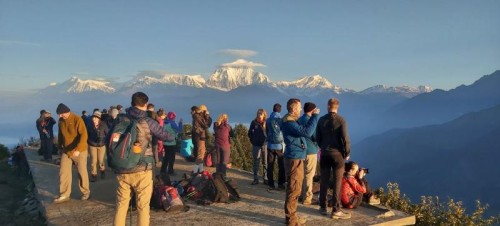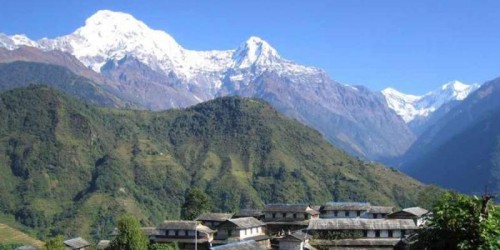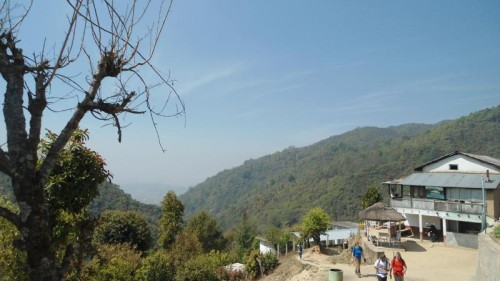Best Time for Pikey Peak Short Trek
The best time to do the Pikey Peak Short Trek is during the spring (March to May), autumn (September to November) and winter (December to February) seasons, as these months offer the most favorable weather and clear mountain views.
Spring (March to May): This season brings vibrant trails filled with blooming rhododendrons and mild temperatures. Visibility is especially excellent in April, offering stunning panoramic views of Everest, other Himalayan peaks, and lush green hills.
Autumn (September to November): Known as the most popular trekking season in Nepal, autumn features stable weather, clear skies, and crisp air following the monsoon. The mountain views are exceptionally sharp, making it ideal for photography and sightseeing.
Winter (December to February): Although the trek is still possible in winter due to the lower altitude of the route, temperatures can be quite cold, especially around Pikey Peak Base Camp and the summit. However, the views are often crystal clear, and the trails are peaceful with fewer trekkers.
Why is Pikey Peak Considered a Short Trek?
There are several reasons why Pikey Peak is considered a short trek.
The first reason is that it takes only 5 days to complete, starting and ending in Kathmandu. Out of these 5 days, 2 are spent on road travel—one day to reach the starting point of the trek and another day to return to Kathmandu from the endpoint. The actual trekking portion lasts just 3 days, making it ideal for trekkers with limited time.
The second reason is that the trail is relatively easy to moderate in difficulty, with good road access from Kathmandu, no requirement for special permits, and no need for extensive acclimatization or technical climbing. These factors contribute to its reputation as a short, convenient, and rewarding Himalayan trek.
The third reason is that the daily walking distance is only about 5 to 8 hours, and the trek reaches an altitude of 4,065 meters at the Pikey Peak summit by the second day of trekking (third day from Kathmandu). Starting from Pattale or Dhap, trekkers can reach the summit within two days. This altitude is high enough to offer breathtaking Himalayan views—including Mt. Everest and other panoramic snow-capped mountains.
Pikey Peak Short Trek Difficulty
The Pikey Peak Short Trek is considered easy to moderate in difficulty. It doesn’t require a high level of physical fitness, but good health and strong determination are important, as the trek involves long ascents and descents, and you should be prepared to walk 4 to 8 hours a day.
This trekking route is an ideal choice for beginners and people of all ages, as it is less challenging compared to other popular treks like the Everest Base Camp or Annapurna Circuit in Nepal.
Pikey Peak Short Trekking Cost
The cost of the Pikey Peak Trek can vary depending on several factors, such as group size, level of service, mode of transportation, and the time of year. Whether you choose a full-board package, hire only a guide and porter, or prefer to trek independently, these choices will affect the total cost.
For the Pikey Peak Short Trek, the cost is USD 470 per person, based on a minimum of two participants. This price covers a 5-day itinerary from Kathmandu to Kathmandu and two nights of hotel accommodation in Kathmandu. Full cost details are provided in the “Cost Included” and “Cost Excluded” sections.
Transport for the Pikey Peak Short Trek
Transportation for the Pikey Peak Short Trek is provided by public jeep as part of our package. However, if you prefer a more comfortable and private option, a private jeep can be arranged at an additional cost. You can choose either a public or private jeep for your journey, depending on your preference and budget.
The road distance is approximately 260 kilometers from Kathmandu to Dhap (the trek starting point) and around 290 kilometers from Phaplu to Kathmandu (the trek ending point). While transportation options are generally straightforward, the remote nature of the area and unpredictable weather conditions mean that careful planning and flexibility are essential for a smooth and safe travel experience.
Accommodation in the Pikey Peak Trek
Accommodation options along the Pikey Peak Short Trekking route are generally basic but comfortable teahouses. On the first night at Dhap, there are three basic teahouses with a total capacity of around 30 people. During peak trekking seasons, accommodations may not be sufficient for groups larger than 30, but experienced guides can manage this by making advance bookings via phone.
On the second night at Jhapre, there are four teahouses, offering sufficient accommodation even during busy times. At Pikey Peak Base Camp, there are three teahouses with slightly better facilities compared to Dhap and Jhapre. On the final night at Phaplu—a larger town—there are plenty of basic accommodation options. For those seeking more comfort, luxury lodges are also available in Phaplu at a higher cost.
Typically, teahouses provide private rooms with twin beds, equipped with blankets and pillows, suitable for twin sharing. Bathrooms are usually shared, with a mix of squat and Western toilets, and some lodges offer hot showers using solar power or gas geysers for an extra fee. Every teahouse has a communal dining area with a heater, where trekkers can eat, relax, and socialize with fellow travelers.
Food in Pikey Peak Short Trek
During the Pikey Peak Short Trek, food options primarily consist of traditional Nepali and Sherpa dishes, with some basic Western meals also available. Each teahouse has a menu, and the food offerings are generally similar at every stop along the route. You can choose your meals based on personal preferences and dietary needs.
Most teahouses grow fresh vegetables in their own gardens and serve them to guests. These family-run lodges often have basic training in food preparation, ensuring hygienic and home-style meals. While Western meals are available, their taste may differ from what you're used to, given the limited ingredients and local cooking methods.
We strongly recommend eating vegetarian during the trek, as fresh meat can be difficult to source and store due to the remote location, lack of refrigeration, and the route’s relatively lower popularity. For the most authentic experience, we highly encourage you to try local Nepali and Sherpa dishes such as:
Dal Bhat: A staple dish served to accompany, consisting of rice served with lentil soup (dal), seasonal vegetables, and pickle.
Momos: Steamed or fried dumplings filled with vegetables, tuna fish, cheese, eggs, potatoes, or a mix, served with dipping sauces.
Thukpa: An energetic noodle soup with vegetables and sometimes eggs, flavored with local spices.
Tibetan Bread: Flatbread fried or baked, often served with honey jam or butter for breakfast or as a snack.
Tsampa: Roasted barley flour, eaten as porridge or mixed with butter tea (suja). It looks similar to baby food.
Drinking Water and Beverages in Pikey Peak Short Trek
Safe and clean drinking water is essential while traveling, and the same applies to the Pikey Peak Short Trek. Since you are coming from a different place and the journey through the Himalayas is long, staying hydrated is vital for completing the trek successfully. It is recommended to consume bottled, boiled, or treated water to prevent waterborne illnesses, aid digestion, and reduce the risk of high-altitude sickness. Bottled water is available at teahouses and shops along the route, with prices increasing as the altitude rises, typically ranging from NPR 50 to NPR 300 per liter.
In addition to drinking water, you will find a variety of other beverages available along the trekking route at restaurants and teahouses. These include hot drinks, soft drinks, and alcoholic beverages. All types of hot drinks such as tea, coffee, hot lemon, lemon ginger honey, and hot chocolate are available throughout the trek. These drinks are often served without sugar, but sugar is usually provided separately. Carbonated beverages like cola and Sprite, as well as bottled water, are widely available. Alcoholic beverages include local alcohol (Raksi), whisky, rum, vodka, and beer.
It is highly recommended that all trekkers bring a reusable water bottle to refill from natural water sources along the route. Many streams, rivers, and taps can be found throughout the trek, but this water should always be purified before drinking. Purification methods include using water purification tablets, filters, or UV purifiers. Your guide can also help you identify safe drinking water sources during the Pikey Peak Short Trek.










 USD 470
USD 470
Khadhar Naim
France
Pikey Peak Trek – 5 days
27th May, 2025
I just completed the Pikey Peak Trek-5 days, and it was awesome! My guide, Purna, was incredibly kind and caring throughout the journey. He offered great flexibility in tailoring the itinerary to suit my experience and comfort level on the Himalayan trails.
What stood out most was his ability to truly understand the different moments of my experience—whether I needed support, space, or encouragement. I also enjoyed genuine moments of conviviality, as if I were traveling with a friend.
Highly recommended!